JEEP WRANGLER 2015 JK / 3.G Owners Manual
Manufacturer: JEEP, Model Year: 2015, Model line: WRANGLER, Model: JEEP WRANGLER 2015 JK / 3.GPages: 695, PDF Size: 20.64 MB
Page 541 of 695

Engine/
TransmissionAxle Model
GCWR
(Gross
Combined
Wt. Rating)
Frontal Area
Max. GTW
(Gross
Trailer Wt.)
Max. Trailer
Tongue Wt.
(See Note)
3.6L/
Automatic
3.73 Two–Door
Sport Model
(4WD)
6,340 lbs
(2 876 kg)
25 sq ft
(2.32 sq m)
2,000 lbs
(907 kg)
200 lbs
(91 kg)
3.6L/Manual 3.21 Two–Door
Sahara
Model
(4WD)
6,353 lbs
(2 882 kg)
25 sq ft
(2.32 sq m)
2,000 lbs
(907 kg)
200 lbs
(91 kg)
3.6L/Manual 3.73 Two–Door
Sahara
Model
(4WD)
6,353 lbs
(2 882 kg)
25 sq ft
(2.32 sq m)
2,000 lbs
(907 kg)
200 lbs
(91 kg)
5
STARTING AND OPERATING 539
Page 542 of 695

Engine/
TransmissionAxle Model
GCWR
(Gross
Combined
Wt. Rating)
Frontal Area
Max. GTW
(Gross
Trailer Wt.)
Max. Trailer
Tongue Wt.
(See Note)
3.6L/
Automatic
3.21 Two–Door
Sahara
Model
(4WD)
6,383 lbs
(2 895 kg)
25 sq ft
(2.32 sq m)
2,000 lbs
(907 kg)
200 lbs
(91 kg)
3.6L/
Automatic
3.73 Two–Door
Sahara
Model
(4WD)
6,383 lbs
(2 895 kg)
25 sq ft
(2.32 sq m)
2,000 lbs
(907 kg)
200 lbs
(91 kg)
3.6L/Manual 4.10 2–Door Rubi-
con Model
(4WD)
6,443 lbs
(2 922 kg)
25 sq ft
(2.32 sq m)
2,000 lbs
(907 kg)
200 lbs
(91 kg)
540 STARTING AND OPERATING
Page 543 of 695
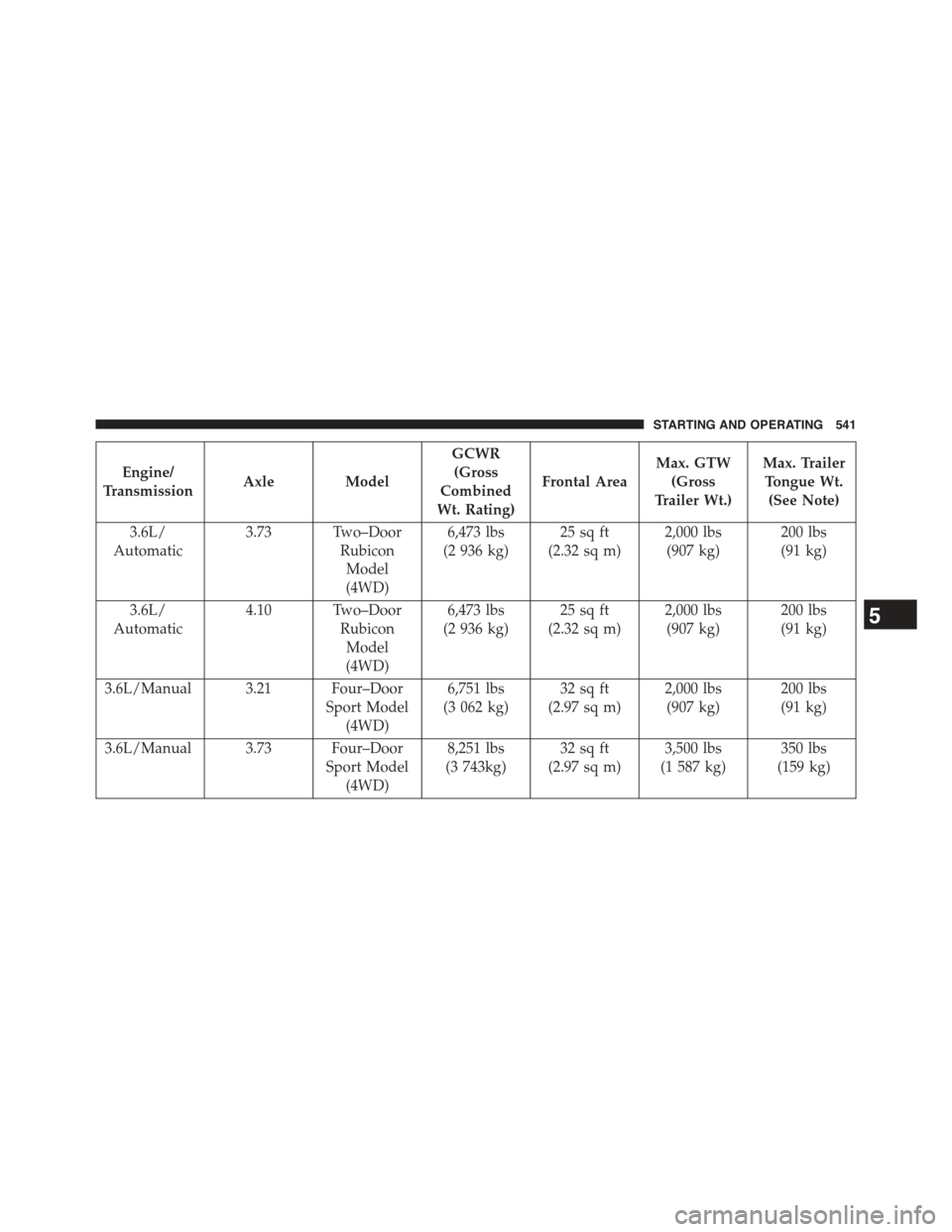
Engine/
TransmissionAxle Model
GCWR
(Gross
Combined
Wt. Rating)
Frontal Area
Max. GTW
(Gross
Trailer Wt.)
Max. Trailer
Tongue Wt.
(See Note)
3.6L/
Automatic
3.73 Two–Door
Rubicon
Model
(4WD)
6,473 lbs
(2 936 kg)
25 sq ft
(2.32 sq m)
2,000 lbs
(907 kg)
200 lbs
(91 kg)
3.6L/
Automatic
4.10 Two–Door
Rubicon
Model
(4WD)
6,473 lbs
(2 936 kg)
25 sq ft
(2.32 sq m)
2,000 lbs
(907 kg)
200 lbs
(91 kg)
3.6L/Manual 3.21 Four–Door
Sport Model
(4WD)
6,751 lbs
(3 062 kg)
32 sq ft
(2.97 sq m)
2,000 lbs
(907 kg)
200 lbs
(91 kg)
3.6L/Manual 3.73 Four–Door
Sport Model
(4WD)
8,251 lbs
(3 743kg)
32 sq ft
(2.97 sq m)
3,500 lbs
(1 587 kg)
350 lbs
(159 kg)
5
STARTING AND OPERATING 541
Page 544 of 695
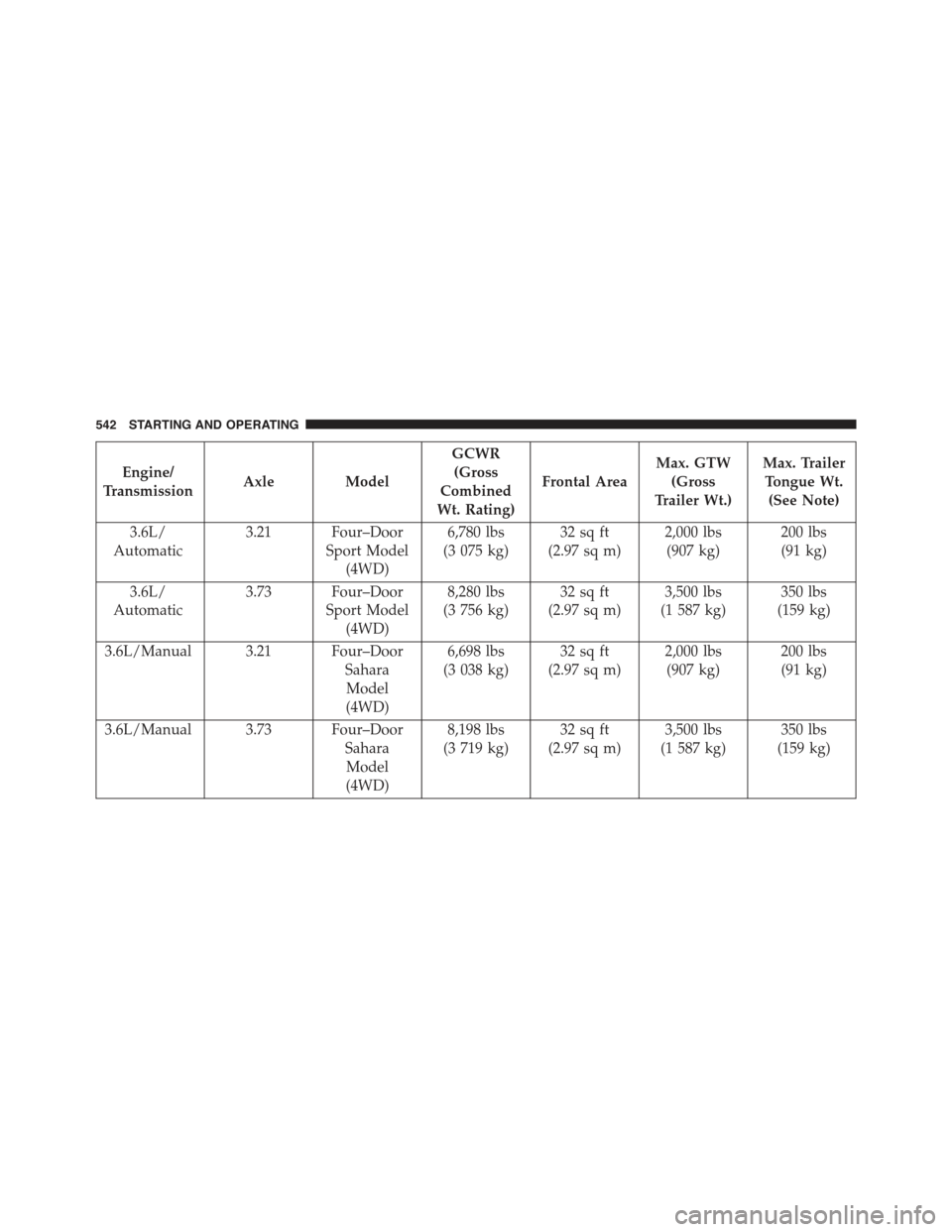
Engine/
TransmissionAxle Model
GCWR
(Gross
Combined
Wt. Rating)
Frontal Area
Max. GTW
(Gross
Trailer Wt.)
Max. Trailer
Tongue Wt.
(See Note)
3.6L/
Automatic
3.21 Four–Door
Sport Model
(4WD)
6,780 lbs
(3 075 kg)
32 sq ft
(2.97 sq m)
2,000 lbs
(907 kg)
200 lbs
(91 kg)
3.6L/
Automatic
3.73 Four–Door
Sport Model
(4WD)
8,280 lbs
(3 756 kg)
32 sq ft
(2.97 sq m)
3,500 lbs
(1 587 kg)
350 lbs
(159 kg)
3.6L/Manual 3.21 Four–Door
Sahara
Model
(4WD)
6,698 lbs
(3 038 kg)
32 sq ft
(2.97 sq m)
2,000 lbs
(907 kg)
200 lbs
(91 kg)
3.6L/Manual 3.73 Four–Door
Sahara
Model
(4WD)
8,198 lbs
(3 719 kg)
32 sq ft
(2.97 sq m)
3,500 lbs
(1 587 kg)
350 lbs
(159 kg)
542 STARTING AND OPERATING
Page 545 of 695

Engine/
TransmissionAxle Model
GCWR
(Gross
Combined
Wt. Rating)
Frontal Area
Max. GTW
(Gross
Trailer Wt.)
Max. Trailer
Tongue Wt.
(See Note)
3.6L/
Automatic
3.21 Four–Door
Sahara
Model
(4WD)
6,728 lbs
(3 052 kg)
32 sq ft
(2.97 sq m)
2,000 lbs
(907 kg)
200 lbs
(91 kg)
3.6L/
Automatic
3.73 Four–Door
Sahara
Model
(4WD)
8,228 lbs
(3 732 kg)
32 sq ft
(2.97 sq m)
3,500 lbs
(1 587 kg)
350 lbs
(159 kg)
3.6L/Manual 4.10 Four–Door
Rubicon
Model
(4WD)
8,326 lbs
(3 776 kg)
32 sq ft
(2.97 sq m)
3,500 lbs
(1 587 kg)
350 lbs
(159 kg)
5
STARTING AND OPERATING 543
Page 546 of 695

Engine/
TransmissionAxle Model
GCWR
(Gross
Combined
Wt. Rating)
Frontal Area
Max. GTW
(Gross
Trailer Wt.)
Max. Trailer
Tongue Wt.
(See Note)
3.6L/
Automatic
3.73 Four–Door
Rubicon
Model
(4WD)
8,355 lbs
(3 790 kg)
32 sq ft
(2.97 sq m)
3,500 lbs
(1 587 kg)
350 lbs
(159 kg)
3.6L/
Automatic
4.10 Four–Door
Rubicon
Model
(4WD)
8,355 lbs
(3 776 kg)
32 sq ft
(2.97 sq m)
3,500 lbs
(1 587 kg)
350 lbs
(159 kg)
Refer to local laws for maximum trailer towing speeds.
544 STARTING AND OPERATING
Page 547 of 695
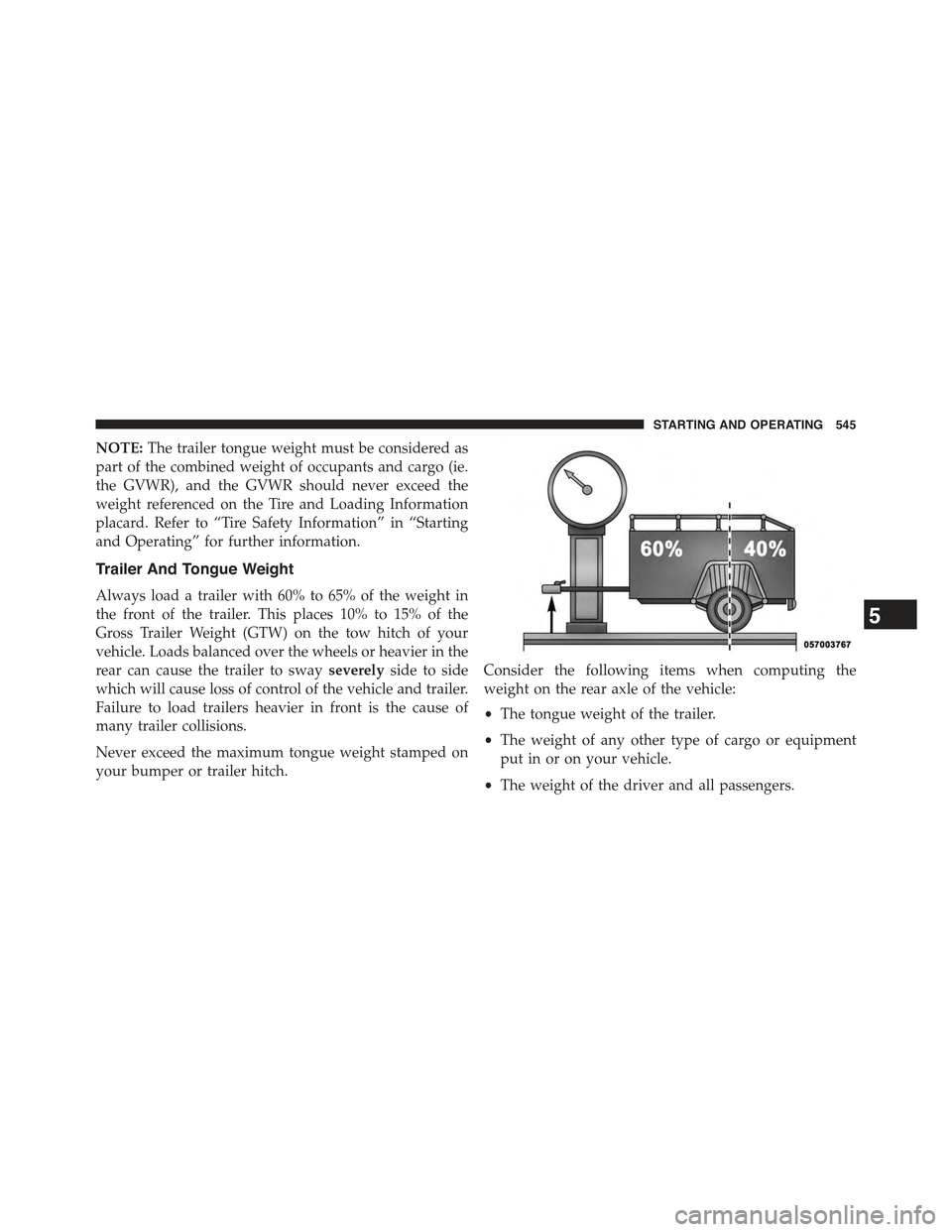
NOTE:The trailer tongue weight must be considered as
part of the combined weight of occupants and cargo (ie.
the GVWR), and the GVWR should never exceed the
weight referenced on the Tire and Loading Information
placard. Refer to “Tire Safety Information” in “Starting
and Operating” for further information.
Trailer And Tongue Weight
Always load a trailer with 60% to 65% of the weight in
the front of the trailer. This places 10% to 15% of the
Gross Trailer Weight (GTW) on the tow hitch of your
vehicle. Loads balanced over the wheels or heavier in the
rear can cause the trailer to swayseverelyside to side
which will cause loss of control of the vehicle and trailer.
Failure to load trailers heavier in front is the cause of
many trailer collisions.
Never exceed the maximum tongue weight stamped on
your bumper or trailer hitch.
Consider the following items when computing the
weight on the rear axle of the vehicle:
•The tongue weight of the trailer.
•The weight of any other type of cargo or equipment
put in or on your vehicle.
•The weight of the driver and all passengers.
5
STARTING AND OPERATING 545
Page 548 of 695
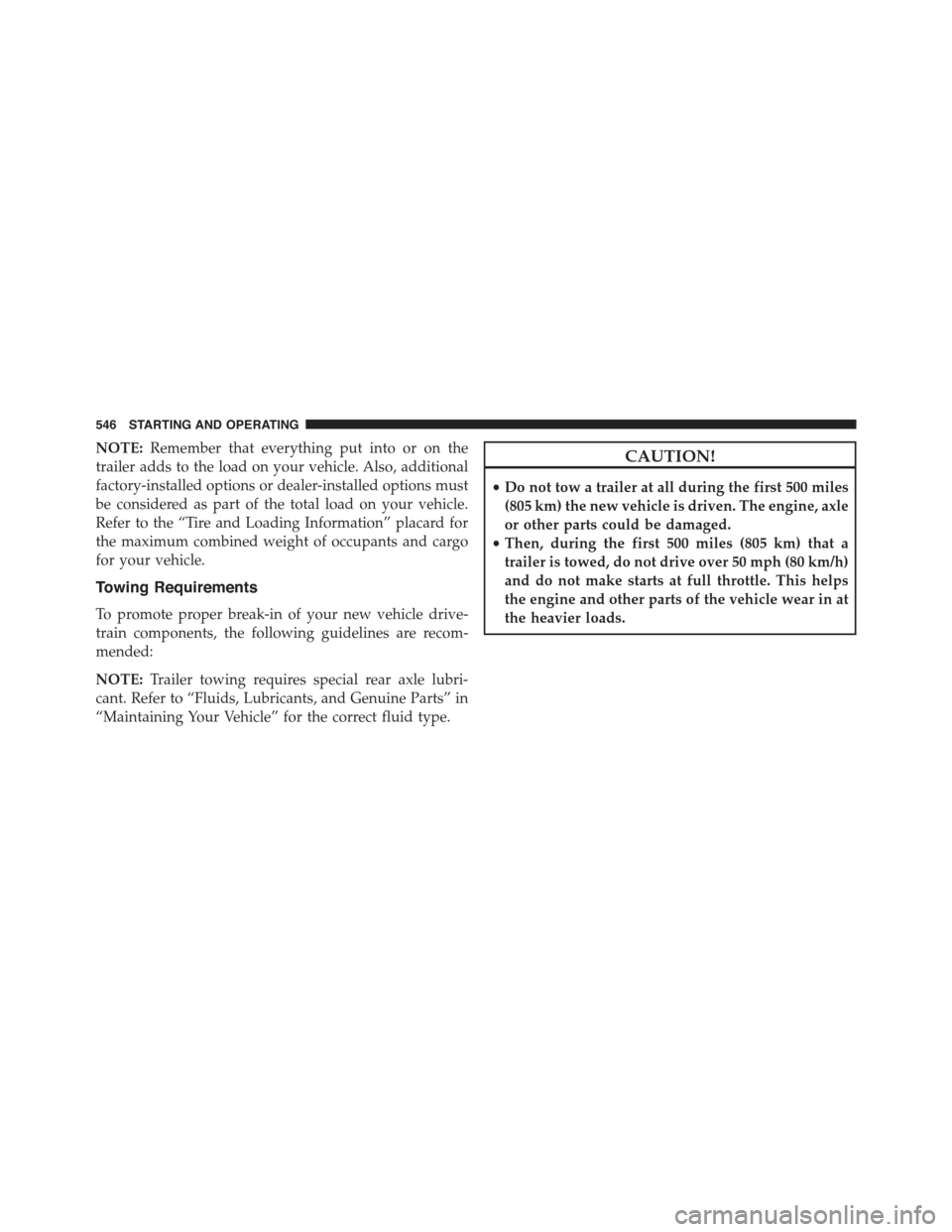
NOTE:Remember that everything put into or on the
trailer adds to the load on your vehicle. Also, additional
factory-installed options or dealer-installed options must
be considered as part of the total load on your vehicle.
Refer to the “Tire and Loading Information” placard for
the maximum combined weight of occupants and cargo
for your vehicle.
Towing Requirements
To promote proper break-in of your new vehicle drive-
train components, the following guidelines are recom-
mended:
NOTE:Trailer towing requires special rear axle lubri-
cant. Refer to “Fluids, Lubricants, and Genuine Parts” in
“Maintaining Your Vehicle” for the correct fluid type.
CAUTION!
•Do not tow a trailer at all during the first 500 miles
(805 km) the new vehicle is driven. The engine, axle
or other parts could be damaged.
•Then, during the first 500 miles (805 km) that a
trailer is towed, do not drive over 50 mph (80 km/h)
and do not make starts at full throttle. This helps
the engine and other parts of the vehicle wear in at
the heavier loads.
546 STARTING AND OPERATING
Page 549 of 695
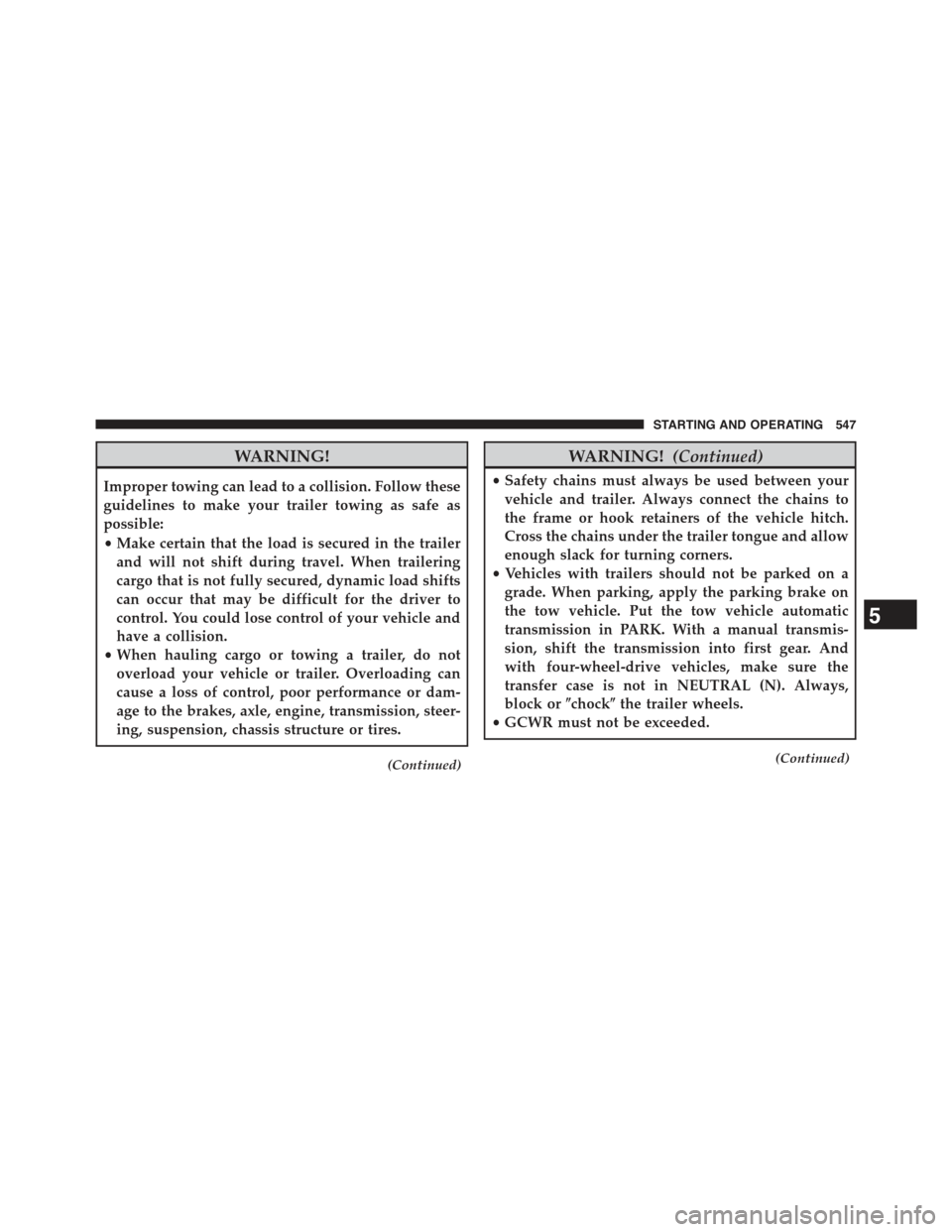
WARNING!
Improper towing can lead to a collision. Follow these
guidelines to make your trailer towing as safe as
possible:
•Make certain that the load is secured in the trailer
and will not shift during travel. When trailering
cargo that is not fully secured, dynamic load shifts
can occur that may be difficult for the driver to
control. You could lose control of your vehicle and
have a collision.
•When hauling cargo or towing a trailer, do not
overload your vehicle or trailer. Overloading can
cause a loss of control, poor performance or dam-
age to the brakes, axle, engine, transmission, steer-
ing, suspension, chassis structure or tires.
(Continued)
WARNING!(Continued)
•Safety chains must always be used between your
vehicle and trailer. Always connect the chains to
the frame or hook retainers of the vehicle hitch.
Cross the chains under the trailer tongue and allow
enough slack for turning corners.
•Vehicles with trailers should not be parked on a
grade. When parking, apply the parking brake on
the tow vehicle. Put the tow vehicle automatic
transmission in PARK. With a manual transmis-
sion, shift the transmission into first gear. And
with four-wheel-drive vehicles, make sure the
transfer case is not in NEUTRAL (N). Always,
block or%chock%the trailer wheels.
•GCWR must not be exceeded.
(Continued)
5
STARTING AND OPERATING 547
Page 550 of 695
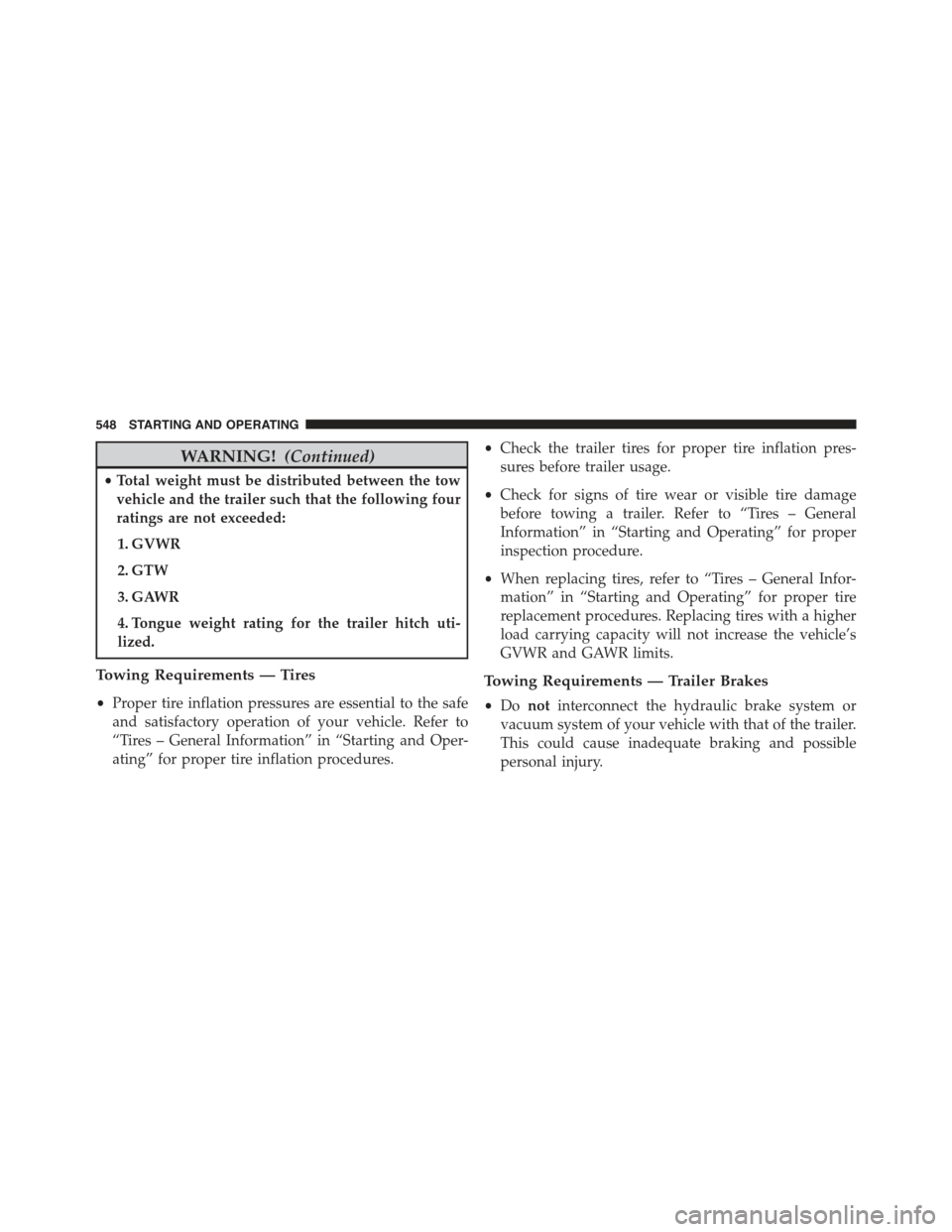
WARNING!(Continued)
•Total weight must be distributed between the tow
vehicle and the trailer such that the following four
ratings are not exceeded:
1. GVWR
2. GTW
3. GAWR
4. Tongue weight rating for the trailer hitch uti-
lized.
Towing Requirements — Tires
•Proper tire inflation pressures are essential to the safe
and satisfactory operation of your vehicle. Refer to
“Tires – General Information” in “Starting and Oper-
ating” for proper tire inflation procedures.
•Check the trailer tires for proper tire inflation pres-
sures before trailer usage.
•Check for signs of tire wear or visible tire damage
before towing a trailer. Refer to “Tires – General
Information” in “Starting and Operating” for proper
inspection procedure.
•When replacing tires, refer to “Tires – General Infor-
mation” in “Starting and Operating” for proper tire
replacement procedures. Replacing tires with a higher
load carrying capacity will not increase the vehicle’s
GVWR and GAWR limits.
Towing Requirements — Trailer Brakes
•Donotinterconnect the hydraulic brake system or
vacuum system of your vehicle with that of the trailer.
This could cause inadequate braking and possible
personal injury.
548 STARTING AND OPERATING